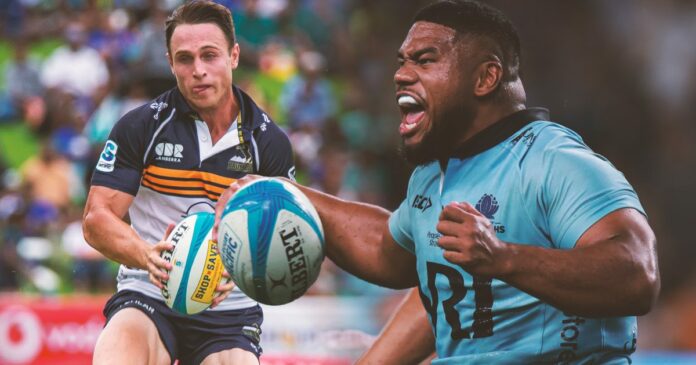Round one of Super Rugby Pacific is done and dusted and all three Australian sides managed to walk away with wins, and the victories have brought extra excitement heading into round two.
The Waratahs and Western Force both clinched their games in the dying minutes in their matches, while the Brumbies worked their way into an early lead, which put them in good stead to close out a tight game.
The most obvious take away by just looking at the scoreboards, is that the Aussie sides all conceded too many points, conceding more than 30-points in each fixture.
Nevertheless, they outscored their opponents which will buoy their coaches, and fans love tries, so no real harm done there from a viewer’s perspective, however, the respective defence coaches will be working overtime to tighten their side’s seams.
Meanwhile, the attack coaches for particularly the Force and Tahs will be looking to sharpen and straighten their attack, as their backlines often went sideways and cramped each other’s space.
The Brums were the best of the bunch, but they weren’t perfect, playing deeper and more passively as the game drew on, with the Fijian Drua putting in massive shots in defence.
Overall, the three Australian sides were too lateral in attack and must straighten their lines to play ontop of defences, to keep themselves on the front-foot.
The best way to illustrate the difference between the sides’ attacks is by highlighting their blocker plays.
Brums set move
Here we see the Brums run a set-piece blocker move, where the No.12, Austin Anderson, is the first receiver who gets the ball when he is flat at the line.
This means the Drua’s defence can’t drift and their No.10, Caleb Muntz, is now having to tackle Anderson, instead of his opposite, Noah Lolesio, who is looping out the back with blindside winger Ollie Sapsford.
Hudson Crieghton’s straight line, along with Andy Muirhead’s, means the Drua’s No.13 and No.14 can’t drift either to cover the two looping Brumbies.
The key reason for the success of the move is that the Brumbies players are always in motion, are flat, and are straight, or straighten when receiving the ball.
All these factors mean the Drua’s threat assessment is constantly changing, and this is where chinks start to appear in defensive lines.
The Brumbies achieved the same deception and defensive manipulation with blocker plays in phase play, because their pods, always had either Lolesio, Anderson or another backline player out the back of the pod, to put the Drua’s defence in two minds.
What was more impressive is they are so well drilled that they can orchestrate this on the fly and are able to adjust their running lines and depth accordingly.
Brums move on the fly
Lolesio adjusts his line and carries flat, Creighton is also running an unders line straight between the last and second last defender.
Sapsford times his run superbly and so does Muirhead, because it gives Lolesio all three options, as well as a cut out to Corey Toole on the wing.
Toole also holds his width beautifully, meaning the Drua’s fullback is caught in no man’s land and must make a pressured read.
A key point to remember, as we go through the Tahs and Force’s examples, is that the Brumbies always make it over the gainline with their moves.
If we start with the Force, they run the exact same move as the Brumbies do in the first video.
Force set move
The move is: the halfback to No.12, to No.13, who has the fullback flat but pulls back to the No.10 who has the blindside winger looping with him; in this instance, Ben Donaldson, the no.10, gets caught well behind the gainline.
You must applaud Moana Pasifika for their linespeed and good defence, but the Force had several small issues in the way they ran this move.
The first issue is that Hamish Stewart, the No.12, catches the ball too deep, second, he’s flat footed and not really in motion, third, he also passes too early to Sio Tomkinson who is also too deep.
This means the Moana No.12 has time to drift onto Tomkinson, who is the No.13, meaning the overlap, which saw the Brumbies get outside the Drua, is completely negated in this instance.
If you compare where Anderson for the Brumbies, and Stewart catch the ball, Anderson almost flat at the line, while Stewart is four metres back from the scrum.
In the Brumbies move, Muirhead, who is the last blocker, also hits a gap, which he would have gone through had Creighton given him the ball.
Conversely, the Force’s Mac Grealy, in the white headgear, is well marked by the Moana No.13 because Tomkinson is too deep and passes too early.
Throughout their game, the Force were often guilty of lacking deception in their shape.
Their forward pods were often lacking a ball player out the back and were set too wide off no.9, which gave the Moana defence time to rush up, and put some sting in their defensive shots, because there was no deception in the attack.
The plays often looked telegraphed.
Moving onto the Waratahs, they had much the same issues as the Force, but their biggest problem was the timing of their runs, not surprising considering so many players had only been in camp for a month.
Tahs set move
Here the Waratahs are playing too deep, Tane Edmed, the Waratahs No.10, is catching the ball in a stationary position about four metres back from the gainline.
Their goal appears to be to get width on the attack but because Edmed is stationary, the Highlanders defensive line drifts off him, and because of the length of the two passes, they have plenty of time to make up the space.
Rob Leota, the Waratahs No.6, and Andrew Kellaway, No.14, actually manage to salvage the situation with strong running lines, but it comes undone after the next pass.
Joey Walton, the No.12, is too deep, and Joseph-Aukuso Suaalii has found himself in no man’s land.
He’s too flat and is still tracking sideways, when he should be a fraction wider and straightening.
Lalakai Foketi’s line would have been fine had Suaalii straightened earlier, and the player in the red head gear, Langi Gleeson, is also a too narrow.
Similar to the Force, the Tahs were too deep initially, and the length of their passes meant the hang time gave the Landers adequate time to adjust.
Gleeson not holding the width and Suaalii not straightening means everything is too lateral and too slow to punish the seams in the Landers defence, because although it broke down here, chinks in their armour were there.
The Australian sides look better in round one than they did a year ago, they look fitter, stronger, and mentally switched-on but they must straighten their attacks or risk being blown off the park by the stronger sides.
Creeping laterally cramps space and means defenders can drift, it also means attacks aren’t playing on top of defences after gainline carries, which negates their upper hand on a backpedalling defensive line.
The Queensland Reds are the only Aussie side yet to play, but considering their attack structures last year, and their several trial matches, it can be expected that their attack will likely resemble the Brumbies’ attack, as opposed to the other two sides’
It will likely be flat, layered, with a short crisp passing game.
It’s only the very start of the season and all three of the Aussie sides which have played will rapidly improve but being indirect in attack can quickly put sides on the back foot and destabilise game plans.
Source link : http://www.bing.com/news/apiclick.aspx?ref=FexRss&aid=&tid=67b6b355597143da83bd3439c2e5c0c7&url=https%3A%2F%2Fwww.rugbypass.com%2Fnews%2Fanalysis-the-biggest-attacking-issues-with-each-australian-super-rugby-side%2F&c=5439731804386728060&mkt=de-de
Author :
Publish date : 2025-02-19 20:13:00
Copyright for syndicated content belongs to the linked Source.



















































